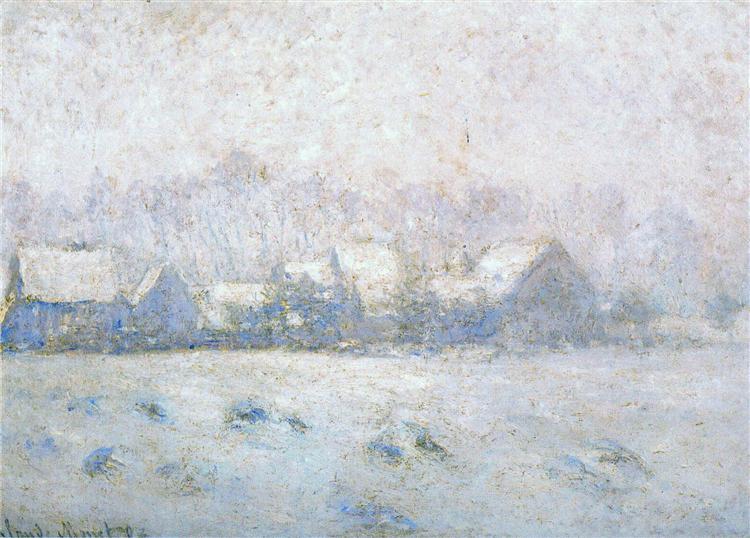Description
The work "Snow - Giverny" (1893) by Claude Monet is one of the compositions that best exemplify the skill of the master Impressionist in capturing the subtleties of light and the atmosphere. In this painting, Monet encapsulates an scene of its immediate surroundings, Giverny's garden, in a moment of winter stillness. The painting evokes a sense of serenity, framed by a neutral palette that, far from being monotonous, is broken down into variations in white, gray and blue, which are intertwined masterfully to create an environment of snowfall.
From the first impression, you can see the technique of loose and dense brushstroke that Monet uses. The brushstrokes are visible, a distinctive seal of their style, transporting the viewer to an almost tactile snow experience. Elite and textures are created from these brushstrokes that suggest both the softness of snow and the roughness of the covered landscape. It is this game of lights and shadows that gives life to a landscape that, in its most basic state, could be considered only white and gray.
In the composition, Monet presents a visual tour that invites you to contemplate the depth of the space. In the foreground, shrubs and branches appear are covered with snow, suggesting life at a station normally considered inhospitable. As the look moves to the bottom, the landscape opens in a soft perspective, where fog and light create an almost dreamlike atmosphere. This resource not only provides depth but also reinforces the idea of a fleeting and changing experience, a recurring theme in Monet's work.
While in "snow effect" there are no human figures present, the absence of human characters further emphasizes the loneliness and tranquility of the winter environment. This can be interpreted as a statement about the artist's relationship with nature and his search for the pure essence of environmental conditions through art. The snow, in its stillness, becomes a character in itself, with the power to radically transform the known landscape.
Monet, throughout his life, became obsessed with the capture of natural light at various times of the day and in different stations of the year. "Snow effect" stands out within your work body, as it is a clear indicative of its ability to articulate changes in winter light and atmosphere. This approach can also be observed in other works of his Giverny series, where the same garden presents a different face at each station, an exploration that not only deals with the external nature, but also of the artist's internal response to the ephemeral beauty .
At a broader level, this work is part of the context of impressionism, a movement that sought to break with the academic traditions of the art of its time. Monet, as one of its main exponents, privileged personal perception above the precise representation, and "snow effect" is a clear testimony of this philosophy. The painting is not only limited to showing a view, but invites the viewer to participate in the sensory experience of winter, evoking a natural and emotional response to the contemplation of its cold landscape.
Finally, "Snow - Giverny" is more than a simple landscape representation; It is a meditation on time, light and nature, characteristics that define Monet's work. With his unmistakable style, the artist manages to transform the everyday into a masterpiece, inviting everyone to see beyond the superficial and to recognize the intrinsic beauty that resides in the natural world.
KUADROS ©, a famous paint on your wall.
Hand-made oil painting reproductions, with the quality of professional artists and the distinctive seal of KUADROS ©.
Reproduction service paintings With a guarantee of satisfaction. If you are not completely satisfied with the replica of your painting, we refund your money 100%.

